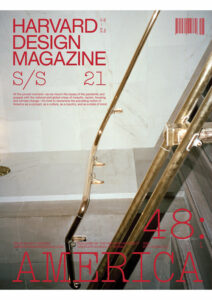“Rerighting” History: The Benito Juarez Community Academy
Who makes architecture? To ask this question in Harvard Design Magazine might seem redundant, but I would like to ask it about a very specific and iconic building in Chicago—the Benito Juarez Community Academy.1 Almost unknown to the architecture community, it is a monument for and by the Pilsen and Little Village communities,2 and it is a testament to the 1968–1974 student and grassroots groups’ protests against the segregated Chicago Public Schools (CPS).
According to a local newspaper, El Mañana: Primero y Unico Diario en Español, the three-story high school was “the first in the city to reflect an ethnic culture influence in its design. It is named in honor of Benito Juarez, a 19th-century Mexican hero who twice became President of Mexico. The facility provides an environment of cultural familiarity and ethnic identification for some 1,700 Latin American students.”3 The school is organized in two major rectangular floor plans, both articulating slanted volumes with the exterior walls, through different gestures, that El Mañana argues “symbolize the sloping walls of Mayan and Aztec architecture.”4 The main academic building containing the classrooms is organized around a three-story patio that serves as a gathering place for the community as well as for the students. The second volume, the physical education building, carries on its exterior wall the iconic mural A La Esperanza.
Beyond the bold geometrical gestures of the volumes, the building features modest but significant traces of an aesthetic that was chosen to reflect a deliberate identity. For example, the small repetitive gaps placed in the interior facade of the patio make the walls look like a kind of celosia. This gesture is articulated with the same material blocks that are used for interior walls of the building, but by placing them differently, they produce tiny gaps that resemble a different materiality. To provide subtle continuity, this pattern is repeated in other areas of the school, including the interior walls of the pool and the basketball court. The building was also designed foreseeing the use of murals: the physical education building articulates a soft material transition in the facade in order to incorporate A La Esperanza. Planning for the mural in advance—rather than as an afterthought—gives it a frame that houses it and highlights it. The patio of the main building was also prepared to house murals on its four corners.
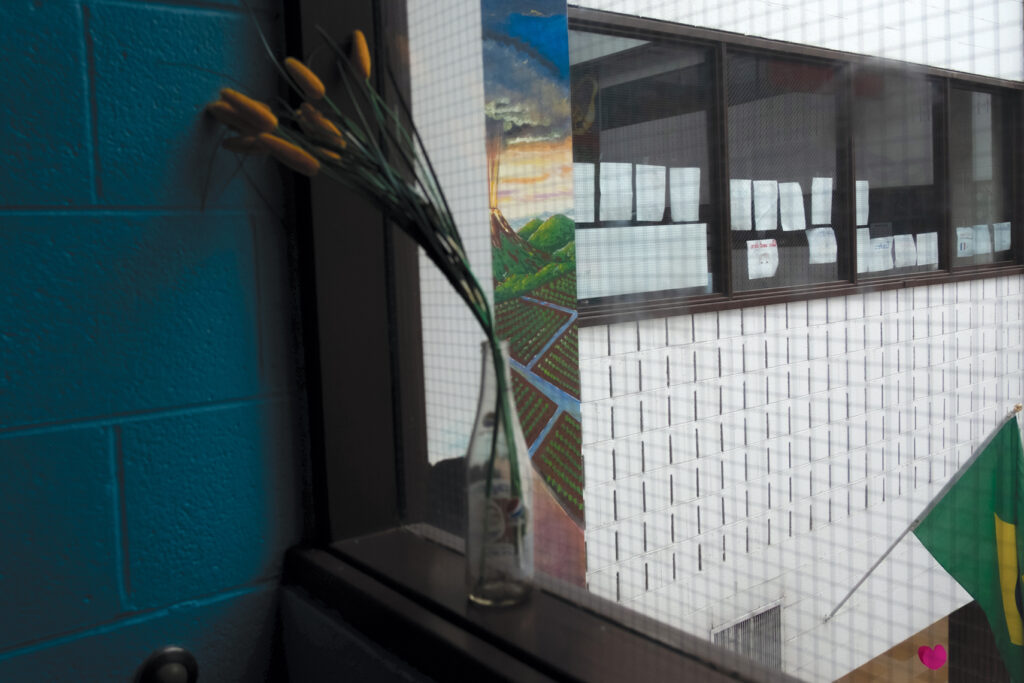
But back to the question of who made this building: the school is publicly attributed to celebrated Mexican architect Pedro Ramírez Vázquez. It appears in some of his published lists of built works5 and he is credited as the architect in the AIA Guide to Chicago. In many ways, this would make sense. He actively contributed to the formation of the modern Mexican identity; working closely with the Mexican government, he became an architectural and political representative of “la Mexicanidad.”6 This could seem to be reason enough for him to be selected to design the first Latino school in Chicago—a city with one of the largest Mexican populations in the US. Ramírez Vázquez’s connection to education was long-standing and what he was most proud of throughout his career. He was a key player on the Comité Administrador del Programa Federal de Construcción de Escuelas, a rural Mexican alphabetization program.7 His design for prefabricated schools, the famous “Aula Casa Rural” (rural home classroom), led to the building of thousands of rural schools and it brought him international recognition when he was awarded the grand prize at the Triennale de Milan in 1960.
Ramírez Vázquez was also an essential figure in the planning of the 1968 Summer Olympics, which originally brought him to Chicago. He was integral in the infrastructure planning (as an architect), as well as in a more diplomatic capacity (due to his long-standing role with the government). When the international press started to air doubts regarding Mexico’s readiness to host the games, Ramírez Vázquez held a press conference at Chicago’s LaSalle Hotel in January 1967 to calm the waters.8 Just a year later, he was back in Chicago—again playing a diplomatic role—to discuss the threat of the so-called boycott of the Olympics by 36 African countries9 (as a protest against the potential presence of South Africa during the apartheid era). Ramírez Vázquez was politically connected in both the US and Mexico—but was that enough to understand, articulate, and represent the struggle of identity of the Mexican diaspora?
It was that same year, 1968, when the actual making of the Benito Juarez School started. And I say “making,” because sometimes the making doesn’t happen only with an architect drafting floor plans or by piling bricks, concrete, or steel, but with bodies and voices on the street. That year, in a milestone in the civil rights history of Chicago, African American students at Harrison High School started a protest against the segregated and racist Chicago public school system. Latinx students soon followed.10 The student walkouts protested the dreadful school infrastructures, discriminatory and racist practices, and the lack of diversity in teachers as well as in the curriculum itself. In Pilsen specifically, students and their community were rallying against the fact that there was no local public high school, which forced Pilsen students into long and troubling commutes. They also demanded “the teaching of Latin American history along with the institutionalization of bilingual-bicultural programs.”11
In 1972, the first Pilsen community signature petition was presented to the board of the CPS to request the construction of a neighborhood high school that would incorporate a bilingual and diverse cultural curriculum. The petition was denied, and a year later, the Froebel Branch of Harrison High School—which was in Little Village and served Pilsen students—was suddenly shut down. The frustration and continued struggle led to a massive uprising on June 5, 1973, with students and community members marching from the Froebel School to the Chicago Board of Education downtown. The following few days of protests resulted in numerous episodes of police brutality against the Chicano community.12
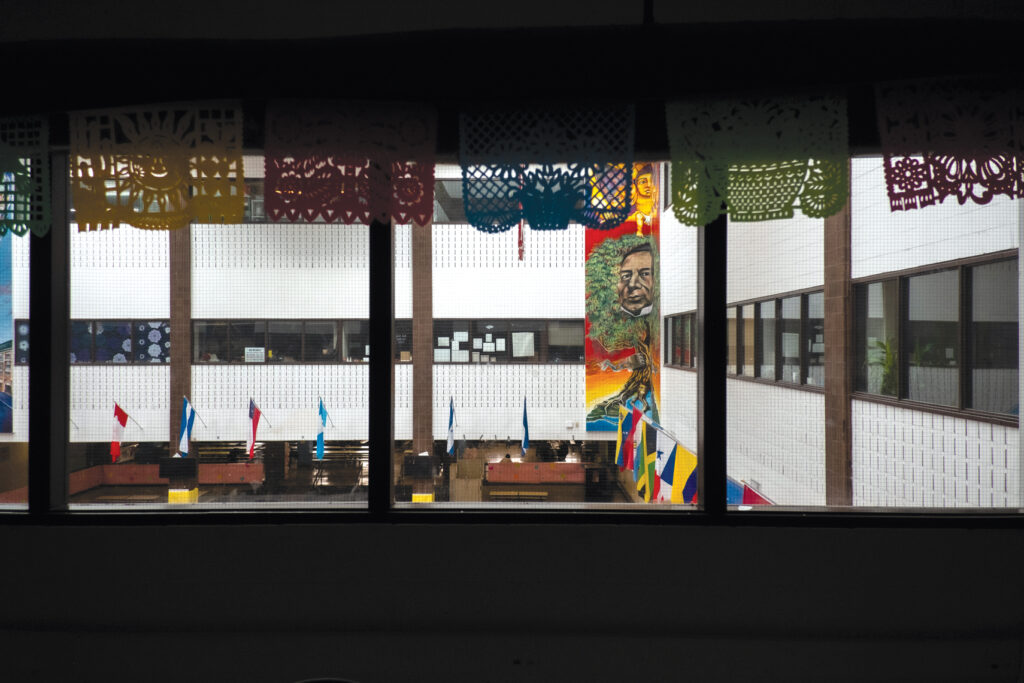
The school walkouts, once initiated by students, had become a whole community effort—they were organized by neighbors, activists, local leaders, and artists, and led by mothers of Pilsen’s kids. On June 13, 1973, “[Mary] Gonzales and [Raquel] Guerrero attended a Chicago Board of Education meeting with dozens of their neighbors filling the seats.”13 That day, the school petition was finally approved (with 8 votes to 1 in favor).14 According to an article in the Chicago Tribune on June 14, 1973, “The Board’s action was considered somewhat unusual because the board made a commitment to build a new school before a specific site was picked or all studies completed on the proposed school.”15 To celebrate that victory, a street party—La Fiesta del Sol—was organized for the first time. Since then, La Fiesta del Sol has been an annual celebration of Pilsen.
The selection of the architect was a weighty decision: the architect would need to materialize the efforts and claims of a community that had already created a school without breaking ground. In fact, the appointment of Ramírez Vázquez was a decisive factor in the opening of the school. As Mary Gonzales explains, it was Mayor Richard J. Daley himself who called the president of Mexico to ask for the best Mexican architect for the school. At first there was some discontent among the community leaders, since the mayor had made the decision without their input. But, according to Gonzales, “Once the news became public, and people found out who he was, I had no control over it. Because the Mexicans of the community (I am Mexican American) went like crazy celebrating the decision. And so [beyond the initial dissatisfaction], I just followed the people, and supported the decision.” Gonzalez notes that, at that time, the majority of Pilsen residents were most likely undocumented and came directly from Mexico. So by embracing Ramírez Vázquez, they were embracing their own country, their own culture. As Gonzales recalls, when Ramírez Vázquez came to Pilsen, “It was a big thing—it was like the president of the United States came to Chicago, [there were] thousands of people on the streets. He gave speeches everywhere, hundreds of people wanted to shake his hand.”16
Meanwhile, according to José Gamaliel Gonzalez, a founding member of El Movimiento Artístico Chicano (MARCH): “Fidel Lopez, a Chicago Mexican architect, complained that the school should be designed by a Chicago Mexican architect.”17 The political forces won out, however, and as one of the conditions of opening of the school, Ramírez Vázquez was selected as the design architect. Fidel Lopez seemed reluctant to work collaboratively, so eventually—as shown in the blueprints—Adrian Lozano was appointed the construction architect. A local Chicago Mexican architect, Lozano18 would later be in charge of building—and subsequently renovating—the National Museum of Mexican Art.19 He also designed the arch that was built in 1990 to mark the entrance to the Little Village (or La Villita) neighborhood in order to recognize the Mexican presence in Chicago after decades of living in the shadows.20
In an added complication, even though the site selected for the school was approved by the board of education in September 1973, it took another year of meetings and marches to force the actual acquisition of the land. After the community–organized “Boycott of Pilsen Schools” in September 1974, the land was finally bought.
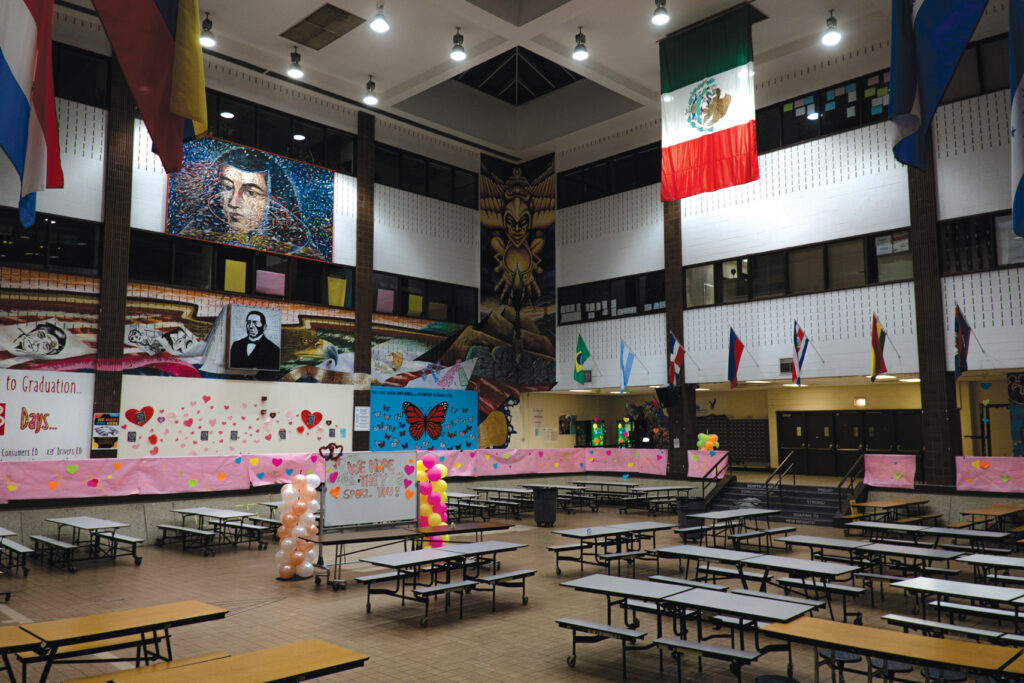
Now one could ask again: who is the architect of this building? But would the answer tell us who made the building? Would it teach us anything about the relevance of the school? I am asking this not only to understand who to name and acknowledge for putting one brick after the other, but to actually decipher how the architectural attributes and the aesthetic imagery of this building came to be. Those are not just the result of the architect’s so-called ideas or design skills. They actually originated from a much more complex apparatus that preceded the architect.
From the beginning, one of the requirements was for the school to include murals. Muralism is integral to the Mexican artistic tradition and it has played a fundamental role in the modernization of Mexico and as a tool for social change. But murals were also central to Pilsen’s identity, as it was for the Chicano movement across the US. It was the art form that most Chicano artists used in service to the community and in order to keep thinking, performing, and representing their identity. In September 1977, the school opened, and two years later—when the first generation of students from Benito Juarez Academy was about to graduate—a competition was held to design the mural for the exterior wall of the physical education building. Casa Aztlán, a group of community teaching artists that had provided experimental art classes to students while the protests were taking place, ran the competition. The five submissions were evaluated by the Pilsen Neighbors Community Council and teachers from the Benito Juarez Academy, and Malú Ortega and Jimmy Longoria’s A La Esperanza proposal was selected.21 The mural was completed with help from Casa Aztlán artists as well as students and members of the community.
The success of the Benito Juarez building comes not just from what the community did, but, more importantly, from the community’s expectations of what that building should do. The Benito Juarez Academy is an outgrowth of a rich ecosystem of movements that represented the struggle of Chicanismo in Chicago and across the US.22 It is also the material trace of many initiatives—such as Mujeres Latinas en Acción, Casa Aztlán, El Hogar del Niño, MARCH or later MIRA (Mi Raza Arts Consortium) in Chicago23—that constructed (and are still constructing) the identity of a community. It is a monument to a community of people who worked to define and identify themselves as Mexicans, as Mexican Americans, as Chicanas/os, as Latinas/os, as Latinx,24 while at the same time claiming their rights to be equals as Americans.
It is a common goal of architectural history, theory, and criticism to decipher and claim the relevance and value of architecture as a discipline. However, in most cases, the relevance of architecture is seen through the lens of the relevance of the architect. This presents many limits and even a flattening of the way architecture itself wants to assert its pertinence and implications (as a cultural and sociopolitical device). I am not arguing this only from the perspective of Bernard Rudofsky’s “Architecture without Architects,” but to question how—if we do accept architecture as a social mediation—we can actively speak about this in equal terms as when speaking about the architect. How can we speak about this when the historical traces of a building are only the sketches, blueprints, models, and/or photographs? How can the documentation of the social and political events be as integral to architectural history as floor plans are? How is it possible that the teaching of the history of a building can happen in isolation from the sociocultural archeology of the building? Ultimately, I question how the relevance of architecture can be claimed only by speaking about architects and “their” buildings.
The construction of the Benito Juarez Academy is a living memory. It is a statement made by many, and to remember many. Even the institutional narrative of the school keeps the memory fresh: Raquel Guerrero, Mary Gonzales, and Teresa Fraga (who joined the struggle later), were honored as the Founding Mothers of Benito Juarez Community Academy. Members of the community—from its beginning and from today—continue to name who made this building. And as artists and scholars Nicole Marroquin and Paulina Camacho put it, that is an effort to reright history.25
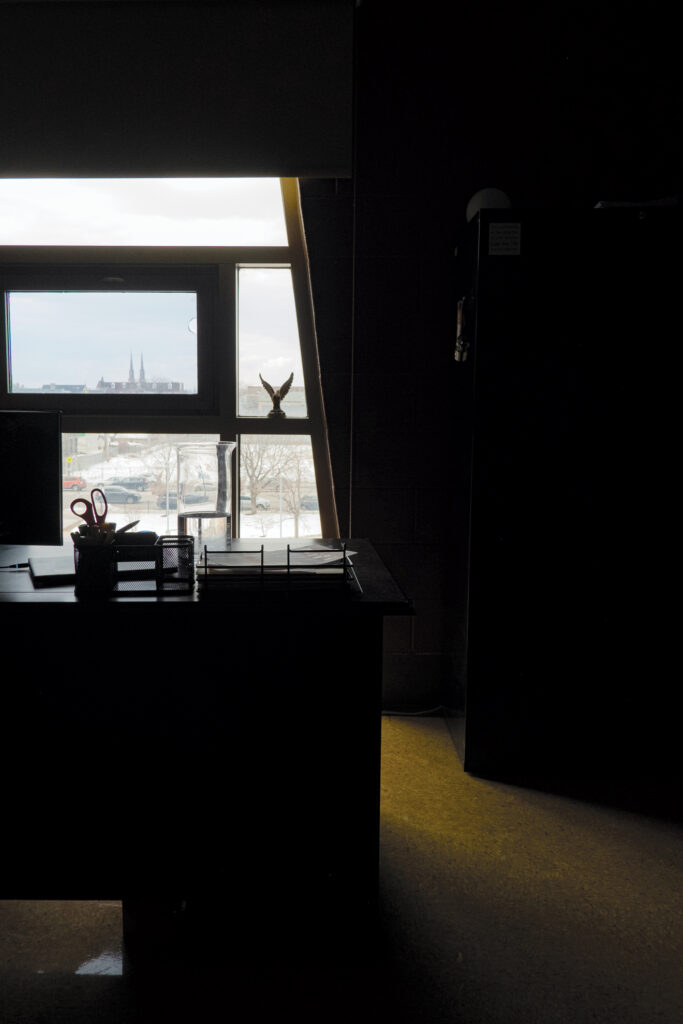
MAITE BORJABAD LÓPEZ-PASTOR is a Spanish architect, curator, and researcher based in Chicago whose work revolves around diverse forms of critical spatial practices, operating across architecture, art, performance, and politics. She is currently art and design curator at the Art Institute of Chicago. Her work has been published in Pin-Up, Domus, Dezeen, Yorokobu, e-flux, the New York Times, the Chicago Tribune, and El Cultural.
